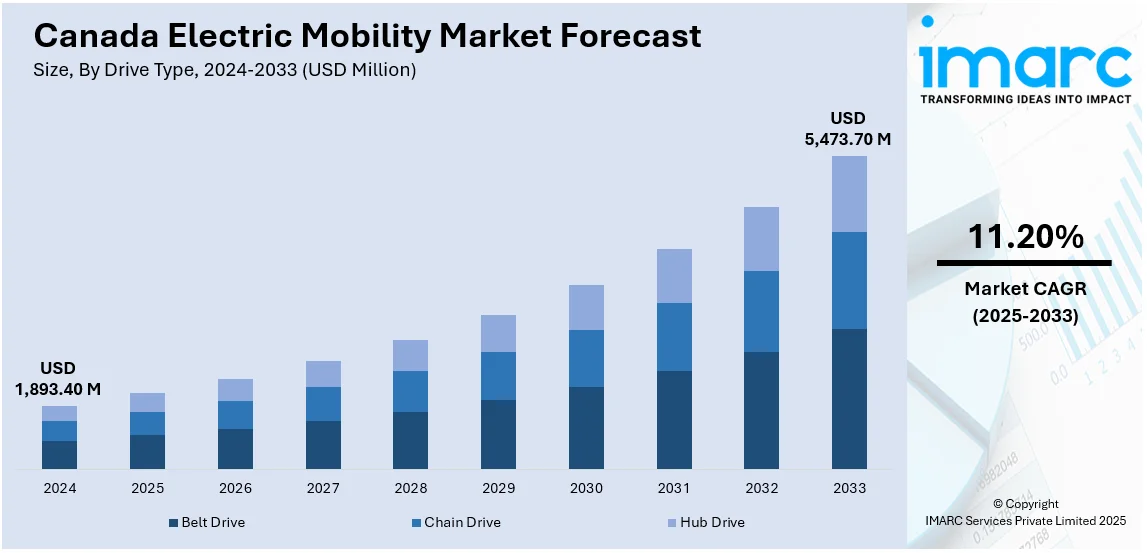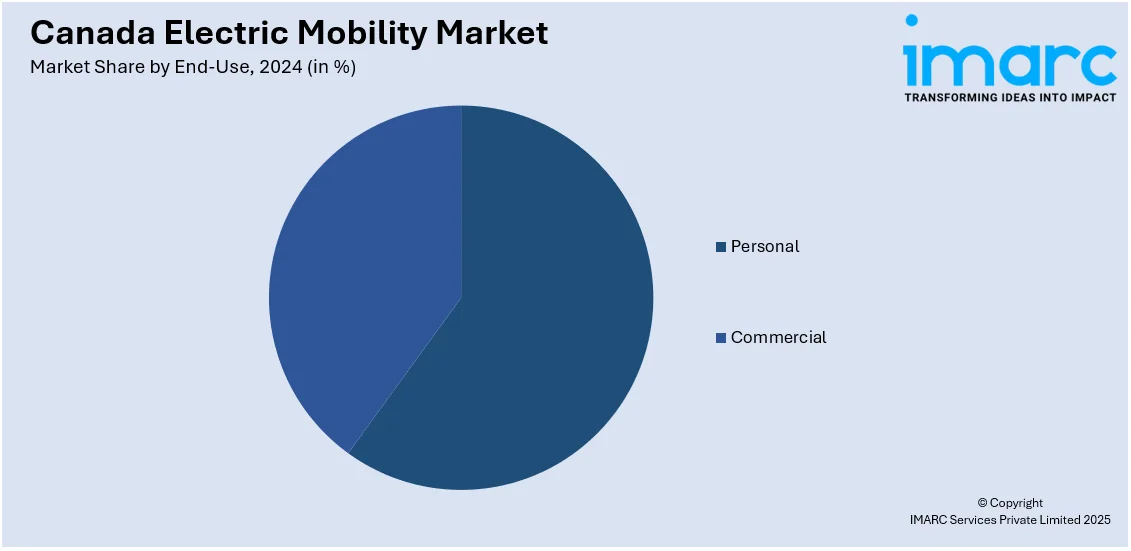
Canada Electric Mobility Market Size, Share, Trends and Forecast by Drive Type, End-Use, Battery, and Region, 2025-2033
Canada Electric Mobility Market Size and Share:
The Canada electric mobility market size reached USD 1,893.40 Million in2024. Looking forward, IMARC Group expects the market to reach USD 5,473.70 Million by 2033, exhibiting a growth rate (CAGR) of 11.20% during 2025-2033. Government incentives, expanding charging infrastructure, stricter emission regulations, declining battery costs, rising fuel prices, increasing consumer awareness of sustainability and technological advancements enhancing vehicle range, performance, and affordability are some of the major factors positively impacting Canada electric mobility market share.
|
Report Attribute
|
Key Statistics
|
|---|---|
|
Base Year
|
2024
|
|
Forecast Years
|
2025-2033
|
|
Historical Years
|
2019-2024
|
| Market Size in 2024 | USD 1,893.40 Million |
| Market Forecast in 2033 | USD 5,473.70 Million |
| Market Growth Rate (2025-2033) | 11.20% |
Canada Electric Mobility Market Trends:
Increased Policy Support and Regulatory Framework
The market is advancing rapidly, driven by strong government policies, initiatives, and regulatory measures. For example, on August 9, 2024, the Canadian government allocated USD 4.2 Million toward projects focused on medium- and heavy-duty vehicles (MHDVs) as part of a USD 7.5 Million initiative to promote ZEVs. This funding, through the Zero-Emissions Vehicles Awareness Initiative, supports public education on ZEV technologies, charging infrastructure, and clean fuels. Additionally, federal and provincial incentives, tax credits, and zero-emission vehicle (ZEV) mandates are accelerating the transition from internal combustion engines. Fuel economy and carbon emission regulations further support the shift, while fleet electrification programs encourage public and commercial transport to adopt electric solutions. Urban planning now integrates EV infrastructure, ensuring long-term adoption, which is contributing to the Canda electric mobility market growth. Carbon pricing mechanisms provide financial incentives for businesses to transition to cleaner transportation, thereby fueling market expansion. These efforts, combined with regulatory measures, position Canada as a key player in global electric mobility, fostering sustainable mobility and strengthening its competitiveness in the clean transportation sector.

Strengthening the Domestic Supply Chain for EV Components
Canada is strengthening its domestic battery production ecosystem by leveraging its reserves of lithium, nickel, and cobalt. This strategy reduces reliance on foreign suppliers, minimizes supply chain risks, and enhances efficiency., thereby creating a positive Canada electric mobility market outlook. Expanding battery manufacturing and processing facilities are creating localized supply networks that lower costs and improve logistics. Automakers, mining companies, and technology firms are collaborating to advance next-generation battery chemistries, improving energy density and durability. Recycling initiatives are reclaiming critical materials from used batteries, supporting circular economy principles, and reducing environmental impact. Government and industry investments are accelerating Canada electric mobility market growth. On July 11, 2024, the Government of Canada plans to invest more than USD 9 Million to fortify British Columbia's domestic lithium battery supply chain. Automakers are also investing in domestic electric powertrain and electronic control system manufacturing, securing Canada’s role in global electric mobility. These developments position Canada as a key player in battery technology and sustainable transportation, ensuring long-term competitiveness in the market.
Canada Electric Mobility Market Segmentation:
IMARC Group provides an analysis of the key trends in each segment of the market, along with forecasts at the country level for 2025-2033. Our report has categorized the market based on drive type, end-use, and battery.
Drive Type Insights:
- Belt Drive
- Chain Drive
- Hub Drive
The report has provided a detailed breakup and analysis of the market based on the drive type. This includes belt drive, chain drive, and hub drive.
End -Use Insights:

- Personal
- Commercial
A detailed breakup and analysis of the market based on the end-use have also been provided in the report. This includes personal and commercial.
Battery Insights:
- Lead-acid Battery
- Lithium-ion Battery
- Others
The report has provided a detailed breakup and analysis of the market based on the battery. This includes lead-acid battery, lithium-ion battery, and others.
Regional Insights:
- Ontario
- Quebec
- Alberta
- British Columbia
- Others
The report has also provided a comprehensive analysis of all the major regional markets, which include Ontario, Quebec, Alberta, British Columbia, and Others.
Competitive Landscape:
The market research report has also provided a comprehensive analysis of the competitive landscape. Competitive analysis such as market structure, key player positioning, top winning strategies, competitive dashboard, and company evaluation quadrant has been covered in the report. Also, detailed profiles of all major companies have been provided.
Canada Electric Mobility Market News:
- September 11, 2024: At the EVVE 2024 conference, Nissan Canada joined Electric Mobility Canada (EMC). The goal of this collaboration is to promote innovation and acceptance of electric vehicles in Canada. Daniel Breton, president and CEO of EMC, expressed excitement about the partnership and emphasized Nissan's dominance in the EV sector.
- November 12, 2024: In order to build more than 1,600 Level 2 and Level 3 EV chargers in Toronto and across the country, the Canadian government announced an investment of USD 8.6 Million. This project, which is supported by Natural Resources Canada's Zero Emission Vehicle Infrastructure Program, is to improve charging infrastructure to accommodate the increasing number of EV users. As of right now, the initiative has helped install over 41,000 EV chargers nationwide.
Canada Electric Mobility Market Report Coverage:
| Report Features | Details |
|---|---|
| Base Year of the Analysis | 2024 |
| Historical Period | 2019-2024 |
| Forecast Period | 2025-2033 |
| Units | Million USD |
| Scope of the Report |
Exploration of Historical Trends and Market Outlook, Industry Catalysts and Challenges, Segment-Wise Historical and Future Market Assessment:
|
| Drive Types Covered | Belt Drive, Chain Drive, Hub Drive |
| End-Uses Covered | Personal, Commercial |
| Batteries Covered | Lead-acid Batter, Lithium-ion battery, Others |
| Regions Covered | Ontario, Quebec, Alberta, British Columbia, Others |
| Customization Scope | 10% Free Customization |
| Post-Sale Analyst Support | 10-12 Weeks |
| Delivery Format | PDF and Excel through Email (We can also provide the editable version of the report in PPT/Word format on special request) |
Key Questions Answered in This Report:
- How has the Canada electric mobility market performed so far and how will it perform in the coming years?
- What is the breakup of the Canada electric mobility market on the basis of drive type?
- What is the breakup of the Canada electric mobility market on the basis of end-use?
- What is the breakup of the Canada electric mobility market on the basis of battery?
- What is the breakup of the Canada electric mobility market on the basis of region?
- What are the various stages in the value chain of the Canada electric mobility market?
- What are the key driving factors and challenges in the Canada electric mobility market?
- What is the structure of the Canada electric mobility market and who are the key players?
- What is the degree of competition in the Canada electric mobility market?
Key Benefits for Stakeholders:
- IMARC’s industry report offers a comprehensive quantitative analysis of various market segments, historical and current market trends, market forecasts, and dynamics of the Canada electric mobility market from2019-2033.
- The research report provides the latest information on the market drivers, challenges, and opportunities in the Canada electric mobility market.
- Porter's five forces analysis assist stakeholders in assessing the impact of new entrants, competitive rivalry, supplier power, buyer power, and the threat of substitution. It helps stakeholders to analyze the level of competition within the Canada electric mobility industry and its attractiveness.
- Competitive landscape allows stakeholders to understand their competitive environment and provides an insight into the current positions of key players in the market.
Need more help?
- Speak to our experienced analysts for insights on the current market scenarios.
- Include additional segments and countries to customize the report as per your requirement.
- Gain an unparalleled competitive advantage in your domain by understanding how to utilize the report and positively impacting your operations and revenue.
- For further assistance, please connect with our analysts.
 Inquire Before Buying
Inquire Before Buying
 Speak to an Analyst
Speak to an Analyst
 Request Brochure
Request Brochure
 Request Customization
Request Customization




.webp)




.webp)












